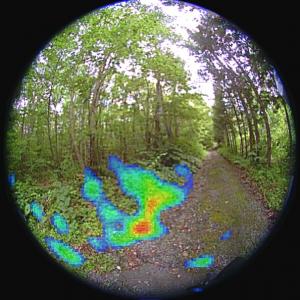Gamma ray camera may help with Fukushima decontamination*

The new Compton camera incorporates high-accuracy, three-dimensional, gamma ray position measurement technology developed at Waseda University. Copyright : Waseda University
Based on a high-sensitivity mobile gamma ray camera released by Hamamatsu Photonics in 2013, the new Compton camera incorporates high-accuracy, three-dimensional, gamma ray position measurement technology developed at Waseda University.
Led by Professor Jun Kataoka, the Waseda team improved the original camera’s resolution by about two times and enhanced its sensitivity by approximately 70%.
The new technology enables the smooth and accurate visualisation of gamma rays, which are invisible to the human eye, and could be used to help with the removal of radioactive substances from the Fukushima Daiichi nuclear accident.
The Waseda team is now working to make the detector even lighter and smaller: only 500 grams or less in weight and about 10 cubic centimetres in size.
Professor Kataoka plans to use the detector to advance
research on bio-function dynamics imaging and proton therapy.
For further information contact:
Professor Jun Kataoka
Research Institute for Science and Engineering
Waseda University, Japan
E-mail: kataoka.jun@waseda.jp
*This article also appears in Asia Research News 2015 (p.10).
Media Contact
All latest news from the category: Power and Electrical Engineering
This topic covers issues related to energy generation, conversion, transportation and consumption and how the industry is addressing the challenge of energy efficiency in general.
innovations-report provides in-depth and informative reports and articles on subjects ranging from wind energy, fuel cell technology, solar energy, geothermal energy, petroleum, gas, nuclear engineering, alternative energy and energy efficiency to fusion, hydrogen and superconductor technologies.
Newest articles

Superradiant atoms could push the boundaries of how precisely time can be measured
Superradiant atoms can help us measure time more precisely than ever. In a new study, researchers from the University of Copenhagen present a new method for measuring the time interval,…

Ion thermoelectric conversion devices for near room temperature
The electrode sheet of the thermoelectric device consists of ionic hydrogel, which is sandwiched between the electrodes to form, and the Prussian blue on the electrode undergoes a redox reaction…

Zap Energy achieves 37-million-degree temperatures in a compact device
New publication reports record electron temperatures for a small-scale, sheared-flow-stabilized Z-pinch fusion device. In the nine decades since humans first produced fusion reactions, only a few fusion technologies have demonstrated…





















